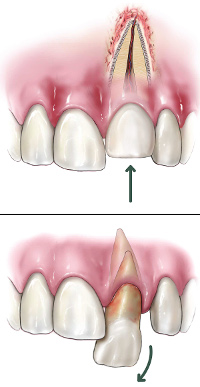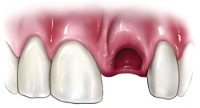Traumatic Injuries
Traumatic dental injuries often occur in accidents or sports-related injuries. Chipped teeth account for the majority of all dental injuries, however, dislodged or avulsed teeth are examples of less frequent, but more severe injuries. Treatment depends on the type, location and severity of each injury.
Dislodged Teeth
 Injuries to the mouth can cause teeth to be pushed sideways, out of or into their sockets. Your endodontist or general dentist may reposition and stabilize your tooth. Root canal treatment is usually started within a few weeks of the injury and a medication, such as calcium hydroxide, will be placed inside the tooth. Eventually, a permanent root canal filling will be implanted.
Injuries to the mouth can cause teeth to be pushed sideways, out of or into their sockets. Your endodontist or general dentist may reposition and stabilize your tooth. Root canal treatment is usually started within a few weeks of the injury and a medication, such as calcium hydroxide, will be placed inside the tooth. Eventually, a permanent root canal filling will be implanted.
Avulsed Teeth
If an injury causes a tooth to be completely knocked out of your mouth, it is important that you are treated immediately! If possible, put the avulsed tooth back into the socket. A tooth can be saved if it remains moist. If you are unable to place the tooth into its socket you can keep the tooth moist in a glass of milk and minimize contact with the root.* After replantation of tooth a stabilizing splint will be placed for a 2-4 weeks. Depending on the stage of root development, root canal treatment will be initiated in 1-2 weeks.
 *The length of time the tooth was out of your mouth and the way the tooth was stored, greatly influence the long-term survival of the tooth.
*The length of time the tooth was out of your mouth and the way the tooth was stored, greatly influence the long-term survival of the tooth.
Click Below For Tips If Your Tooth Has Been Knocked Out
-
5 steps to saving your tooth
1. Pick up the tooth by the crown (the chewing surface) NOT the root.
Locate the tooth immediately; don't leave it at the site of the accident. Handle the tooth carefully when you pick it up, and never touch the root of the tooth, only the crown (chewing surface).
2. If dirty, gently rinse the tooth with water.
Use only water to gently rinse off any dirt. Do not use soap or chemicals. Don’t scrub or dry the tooth, and don’t wrap the tooth in a tissue or cloth.
3. Reposition the tooth in the socket immediately, if possible.
Try to put the tooth back into its socket right away. Gently push it in with your fingers, by handling the crown, or position it above the socket and close your mouth slowly. Hold the tooth in place with your fingers or by gently biting down on it.
4. Keep the tooth moist at all times.
The tooth must stay moist at all times, either in your mouth or, if it can’t be replaced in the socket, put it in milk, in your mouth next to your cheek, or in an emergency tooth preservation kit (such as Save-a-Tooth®). Don’t use regular tap water; root surface cells can’t tolerate that for extended periods of time.
5. See an endodontist or dentist within 30 minutes of the injury.
Bring the tooth with you to your emergency appointment ideally. It's best to see the doctor within 30 minutes; however, it is possible to save a tooth even if it has been outside the mouth for an hour or more.